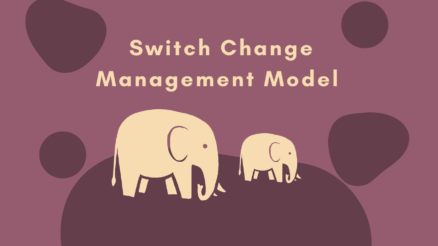Have you ever wondered why some change leaders effortlessly communicate organizational changes while others struggle to talk about change?
The answer lies in the art of storytelling.
Change management, the process of guiding individuals and organizations through periods of transformation, requires effective communication strategies that resonate with people at an emotional level.
And storytelling has emerged as a powerful tool, engaging and inspiring employees, aligning diverse perspectives, and driving successful change initiatives.
This blog post explores the fascinating world of storytelling and explains change management storytelling examples and techniques that can help organizations harness their potential for driving positive change.
So, get ready to discover the captivating role of storytelling in navigating the turbulent waters of organizational transformation.
Let’s start
Communication is key to successful change management
Effective communication is crucial in change management as it is the foundation for successful organizational transformations. Change initiatives inherently disrupt established norms and routines, leading to uncertainty, resistance, and even fear among employees.
Without clear and transparent communication, these emotions can escalate, resulting in decreased morale, productivity, and, ultimately, the failure of the change effort. Effective communication in change management helps to create a shared understanding of the need for change, the vision for the future, and the specific steps involved.
It builds trust, reduces resistance, and fosters a sense of inclusivity and engagement among employees. Additionally, it provides a platform for addressing concerns, clarifying expectations, and ensuring alignment throughout the organization. Organizations can navigate change more smoothly by prioritizing and executing effective communication strategies, increasing employee buy-in, and achieving successful outcomes.
The Power of Stories in Change Management
The three factors explain why stories are powerful tools for communicating organizational change.
Stories engage and resonate with people
Stories possess a remarkable power to engage and resonate with people in the context of change management. Unlike dry facts and figures, stories can tap into emotions and connect with individuals on a deeper level.
They create a narrative that captivates attention, evokes empathy, and stirs the imagination. Through relatable characters, vivid descriptions, and compelling plotlines, stories draw individuals into the change journey, making it more relatable and tangible.
By appealing to human nature’s rational and emotional aspects, stories forge a strong connection, fostering understanding and empathy among stakeholders. They enable individuals to see themselves within the narrative, facilitating a sense of ownership and motivation to embrace the change.
Stories as a means to create a shared understanding
Stories are a powerful means to create a shared understanding among individuals and organizations changing.
In change management, different stakeholders often hold diverse perspectives, experiences, and knowledge levels. This can lead to misunderstandings, misalignment, and resistance to change.
However, stories have the unique ability to bridge these gaps by providing a common reference point. By presenting the change initiative through a narrative lens, stories offer a shared context that transcends individual differences.
They allow stakeholders to see the bigger picture, understand the reasons behind the change, and grasp the intended outcomes. Through storytelling, complex concepts, and ideas can be simplified and accessible to various audiences.
Stories enable people to connect the dots, find common ground, and collectively embrace the change journey, fostering a sense of unity and shared purpose.
The emotional impact of stories in change initiatives
The emotional impact of stories in change initiatives is profound and can catalyze successful transformation.
Unlike logical arguments or data-driven presentations, stories can evoke emotions and create a personal connection with the audience. When changing, individuals often experience various emotions, such as fear, uncertainty, and resistance.
Stories tap into these emotions, helping individuals empathize with the characters and situations portrayed. By appealing to the heart, stories can inspire and motivate individuals to embrace change, overcome challenges, and envision a brighter future.
Emotional resonance helps break down barriers, foster trust, and build a sense of camaraderie among stakeholders. When emotionally engaged, people are more likely to invest their energy and commitment into making the change a success.
Types of Stories in Change Management
The following are the most common types of stories in change management:
1. Success stories
Success stories are a valuable type of storytelling in change management that involves highlighting previous successful changes within an organization. These stories showcase specific instances where change was effectively implemented, resulting in positive outcomes and achievements.
Success stories serve multiple purposes in change management.
Firstly, they inspire and motivate employees by providing tangible examples of how change can lead to success. By sharing stories of past accomplishments, organizations can create a sense of optimism and confidence among individuals who may be skeptical or resistant to change.
Secondly, success stories provide practical insights and lessons learned that can guide current change initiatives. They offer valuable information on what worked well, the strategies employed, and the challenges overcome.
2. Vision stories
Vision stories play a crucial role in change management by compellingly depicting the desired future state. These stories provide a clear and inspiring vision of the organization’s future after the change is successfully implemented.
Through vivid descriptions and engaging narratives, vision stories create a shared understanding of the future direction and purpose. They capture the hearts and minds of individuals, fueling their motivation and commitment to achieve the envisioned state.
Vision stories go beyond presenting facts and figures; they tap into emotions, ignite aspirations, and create a sense of possibility. By effectively communicating the benefits and opportunities that lie ahead, vision stories help stakeholders connect with the change at a deeper level and align their actions towards the shared vision.
They serve as a guiding light, inspiring individuals to overcome obstacles, embrace innovation, and work collectively towards turning the vision into reality.
3. Personal stories
Personal stories are compelling storytelling in change management that involves sharing individual experiences and perspectives related to the change.
These stories provide a human element to the change process by allowing individuals to share their journeys, challenges, and growth. Personal stories create a sense of authenticity and relatability as they highlight the impact of change on a personal level.
By sharing their experiences, individuals can express their emotions, voice concerns, and provide insights that may resonate with others facing similar situations.
Personal stories help foster empathy and understanding among stakeholders by showcasing the diverse perspectives and reactions that arise during change.
4. Resistance stories
Resistance stories involve addressing concerns and overcoming resistance within an organization. These stories provide a platform for acknowledging and empathizing with individuals who may be hesitant or resistant to the proposed change.
By sharing stories highlighting common resistance points and the challenges others face, organizations can address these concerns head-on and provide reassurance.
Resistance stories demonstrate that resistance is a normal part of the change process and can be overcome. They offer insights into successful strategies, coping mechanisms, and lessons learned from individuals who have navigated similar challenges.
5. Cultural stories
Cultural stories showcase the organization’s culture, heritage, and core principles, creating a sense of identity and purpose. By sharing cultural stories, organizations communicate the importance of these values in the context of change.
These stories often highlight past successes and pivotal moments that have shaped the organization’s identity. They serve as a reminder of the organization’s history, traditions, and unique strengths.
Cultural stories help individuals connect with the larger purpose of the change by emphasizing how it aligns with the organization’s values and beliefs.
Using Storytelling Techniques in Change Management
Following are some powerful techniques that can be used in change management storytelling:
A. Crafting a compelling narrative
To craft a compelling narrative, change managers must carefully structure the story with a clear beginning, middle, and end.
They should define the protagonist—the main character or the organization changing—and establish the context and challenges they face.
The narrative should also highlight the desired outcomes and the transformational journey.
By weaving in conflict, tension, and resolution elements, change managers can create a story that grabs attention and keeps stakeholders invested.
Using vivid descriptions, compelling dialogue, and personal anecdotes can bring the story to life and resonate with the audience.
A well-crafted narrative creates a sense of purpose, connects with individuals emotionally, and inspires them to participate in the change journey actively.
B. Identifying the target audience and tailoring stories accordingly
Different organizational stakeholders may have varying perspectives, needs, and levels of understanding regarding the change.
Therefore, it is essential to identify the specific audience or groups affected by the change and customize the stories to resonate with them.
This involves understanding their motivations, concerns, and expectations related to the change.
By tailoring the storytelling approach to the target audience, change managers can ensure that the stories address their specific interests and connect with their experiences.
This may involve using language and examples relevant to their roles and departments, highlighting the benefits and impact of the change from their perspective, and addressing any potential resistance or challenges they may face.
C. Incorporating visuals and multimedia elements
Visuals such as images, infographics, charts, and videos can bring the change narrative to life and make it more memorable.
They visually represent key concepts, data, and messages, making them easier to understand and retain.
Visuals can also evoke emotions and create a more immersive storytelling experience.
For example, photographs or videos of individuals affected by the change can add a human touch and generate empathy.
Additionally, multimedia elements like animations, interactive presentations, and virtual reality experiences can further enhance the storytelling impact by offering a dynamic and interactive way for stakeholders to explore the change journey.
D. Leveraging metaphors and analogies to simplify complex concepts
Metaphors and analogies bridge unfamiliar or abstract ideas and something more familiar or concrete.
By drawing parallels between the change initiative and relatable experiences or objects, change managers can help stakeholders grasp and internalize the key concepts more easily.
For example, comparing the change process to a journey, with its milestones, challenges, and rewards, can help individuals understand the different stages of the change and the importance of perseverance.
Similarly, the puzzle analogy can convey that change requires all the pieces to come together for the bigger picture to emerge.
Metaphors and analogies engage the imagination, making the concepts more vivid and understandable. They enable individuals to see the change differently, facilitating comprehension and creating a shared understanding among stakeholders.
By leveraging metaphors and analogies, change managers can simplify complex ideas, enhance clarity, and foster better communication and alignment throughout the change process.
E. Incorporating storytelling into various change management activities
Incorporating storytelling into various change management activities can significantly enhance their effectiveness and impact. Here are some examples of how storytelling can be integrated into different change management activities:
1. Town Hall Meetings: Use storytelling to kick off or conclude town hall meetings. Start by sharing a compelling story highlighting the need for change or illustrating the desired future state. This helps set the context and engage participants emotionally. Throughout the meeting, include relevant stories that demonstrate the change initiative’s progress, challenges, and successes. Stories can also address concerns or resistance, providing real-life examples of how others have overcome similar obstacles.
2. Training Sessions: Integrate storytelling into training sessions to make complex concepts more relatable and memorable. Use stories to illustrate key principles, best practices, and lessons learned. Encourage participants to share their stories about the change, fostering a sense of connection and collaboration. Incorporate visuals like infographics or videos to enhance the storytelling experience and facilitate understanding.
3. Communication Materials: Infuse storytelling into written and visual communication materials, such as newsletters, emails, and presentations. Craft narratives that convey the change initiative’s purpose, benefits, and progress. Include testimonials or case studies that highlight the impact of the change on individuals or teams. Use storytelling techniques like metaphors or analogies to simplify complex information and engage readers or viewers.
4. Team Meetings: Introduce storytelling activities during team meetings to encourage dialogue, reflection, and shared understanding. Ask team members to share their experiences or challenges related to the change and discuss how they have navigated them. Facilitate storytelling exercises where individuals can express their emotions, insights, and lessons learned. This creates a safe and supportive environment for open communication and fosters a sense of unity within the team.
5. Leadership Presentations: Leaders can leverage storytelling to inspire and motivate their teams during change initiatives. Share personal stories that demonstrate vulnerability, resilience, and growth. Connect these stories to the larger vision and purpose of the change, emphasizing the shared values and desired outcomes. Use storytelling techniques like vivid descriptions and compelling narratives to captivate the audience and create an emotional connection.
Change Management Storytelling Examples
These examples highlight how organizations have effectively utilized storytelling in change management initiatives. During mergers, digital transformations, cultural changes, process improvements, or leadership development, storytelling is crucial in engaging stakeholders, building understanding, and driving successful change.
1. Merger and Integration
In this example, two companies, X and Y, merged to create a stronger, unified organization. To facilitate the integration process, the change management team used storytelling techniques. They crafted a narrative emphasizing the shared vision, complementary strengths, and opportunities resulting from the merger. Personal stories from employees of both companies were shared to highlight the benefits of collaboration and the potential for personal and professional growth. These stories helped create a sense of unity, build trust, and alleviate employee concerns, ultimately leading to successful integration.
2. Digital Transformation
Organization Z Organization Z embarked on a digital transformation journey to modernize its operations and improve efficiency. As part of their change management strategy, they employed storytelling to communicate the benefits and impact of the digital transformation to stakeholders. They shared stories of employees who embraced new technologies, describing how they simplified their work, increased productivity, and empowered them to deliver better results. These stories helped alleviate fears of job displacement and demonstrated the organization’s commitment to providing employees with the tools and skills necessary for success in the digital age.
3. Cultural Change
Company A Company A recognized the need for a cultural shift to foster a more inclusive and collaborative environment. To initiate this change, they utilized storytelling to engage employees and communicate the importance of embracing diversity and collaboration. They shared personal stories from employees who had experienced the positive impact of inclusivity in their work and personal lives. These stories highlighted the value of diverse perspectives, teamwork, and mutual respect. By connecting emotionally with employees, the storytelling approach helped create a shared understanding, inspired behavior change, and fostered a more inclusive culture.
4. Process Improvement
Organization B Organization B aimed to streamline its processes to enhance operational efficiency. To facilitate this change, they utilized storytelling to illustrate the benefits of process improvement. They shared stories of employees who had experienced frustrations and bottlenecks due to outdated processes, highlighting the impact on their productivity and job satisfaction. These stories were paired with success stories of teams implementing process improvements and achieving remarkable results, such as reduced cycle times and improved customer satisfaction. The storytelling approach helped create a sense of urgency, motivate employees, and generate buy-in for the process improvement initiative.
5. Leadership Development
Company C Company C recognized the importance of developing strong leaders to drive change and promote a culture of innovation. They incorporated storytelling into their leadership development programs to inspire and educate emerging leaders. Accomplished leaders within the organization shared their leadership journeys, including the challenges they faced, the lessons they learned, and the impact they made. These stories provided valuable insights and served as role models for aspiring leaders. By incorporating storytelling, Company C effectively conveyed the qualities and behaviors of effective leaders and motivated participants to develop their leadership skills.
Final Words
Storytelling is a powerful tool in change management. It can engage and resonate with people emotionally, creating a shared understanding and driving successful change initiatives. Change management storytelling examples demonstrate the value and effectiveness of storytelling in driving positive organizational change. So, by harnessing the power of storytelling, organizations can inspire, engage, and motivate stakeholders, facilitating a smooth and successful transition in times of change.



